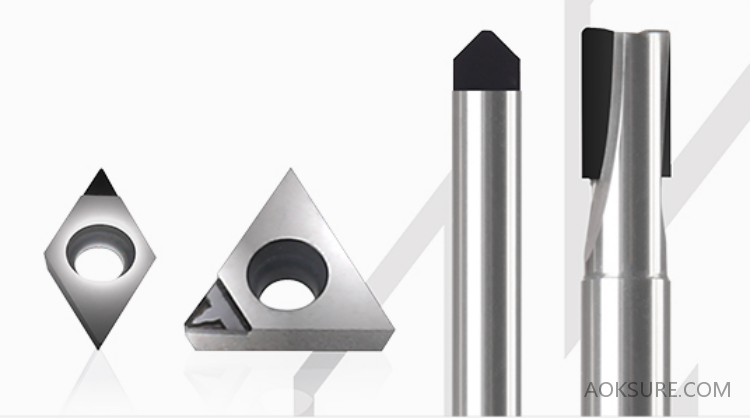
Polycrystalline Diamond (PCD) is a composite material composed of diamond and cemented carbide, usually by assembling diamond powder with a certain amount of binder and cemented carbide matrix, and then under ultra-high temperature and high pressure conditions Made under sintering.
PCD has the characteristics of extremely high wear resistance and hardness, low friction coefficient, high thermal conductivity, etc., so that PCD tools can achieve high-speed, efficient and high-precision processing, which has a wide range of fields in aerospace, automotive, electronics, wood and stone Application prospects.
1. PCD performance characteristics
(1) High hardness and wear resistance
PCD has the characteristics of high hardness, high compressive strength, good thermal conductivity and wear resistance, and can obtain high processing accuracy and processing efficiency in high-speed cutting. This characteristic of the PCD tool is determined by the state of the diamond crystal. This structure has a strong binding force and directionality, thus giving the diamond a very high hardness.
(2) Isotropic, no cleavage plane
PCD is a polymer synthesized by micro-level or sub-micro-level diamond particles through a certain method. The chaotic nature of the disorderly accumulation of particles leads to its isotropy, which can exert the best performance when cutting workpieces without selecting the direction. At the same time, it is not easy to split along a single cleavage surface, which optimizes the mechanical properties.
(3) High processing accuracy
PCD tools have a low coefficient of thermal expansion and a high modulus of elasticity, so the tool is not easy to deform during cutting, at the same time it can reduce the cutting force and cutting temperature, improve the durability and cutting rate of the tool, so as to obtain a good machining surface .
(4) Low friction coefficient
PCD has a low coefficient of friction, and has a low affinity with non-ferrous and non-metallic materials. Not only can it reduce deformation and cutting forces, but also it does not produce built-up edges during cutting, which greatly reduces the roughness of the workpiece surface.
(5) High thermal conductivity
The thermal conductivity of PCD is very high, better than silver and copper, and much higher than that of ordinary cemented carbide, so it is easy to dissipate heat during cutting and the cutting temperature is low.
2. Application of PCD
(1) Application of PCD in automotive and aerospace fields
In the automotive field, PCD tools are mainly used to process skirts, pin holes, cylinder blocks, gearboxes, etc. of engine pistons. Due to the high silicon content of these parts (more than 10%), the service life of the tool is high, and the durability of the PCD tool is 1-50 times that of the cemented carbide tool, which can ensure the stability of the part size, and Greatly improve the cutting speed, processing efficiency and surface quality of the workpiece.
In the aerospace field, PCD tools are used to process aluminum alloy (AlSi2) cylinder heads. The cutting rate is higher, and the tool life is about 20 times higher than that of cemented carbide. The surface quality of the workpiece is also greatly improved.
(2) Application of PCD in the wood processing industry
Wood processing is also an important area for PCD tool applications. With the rapid development of synthetic boards (medium density fiberboard, particle board and composite flooring, etc.), the demand for super-hard tools has been accelerated, and PCD tools have gradually replaced traditional woodworking tools in the market.
The outermost layer of Al2O3 in the reinforced composite floor wears hard carbide tools very much. PCD tools can effectively solve this problem. Therefore, the main market of PCD in the woodworking industry is the processing of laminate flooring and high-hardness fiberboard.
(3) Application of PCD in electronic processing industry
In the electronics industry, the requirements for the production of electrical printed boards are becoming higher and higher. General tools will have burrs during use, which affects the installation and positioning of electrical components, and the entire printed board is not beautiful; hard alloy tools have short life in processing 2. Slow processing speed, low efficiency and poor processing precision. Using PCD tools, the processing efficiency is high, the processing cost is low, and the application is relatively wide.
(4) Application of PCD in glass cutting and processing industry
The cutter wheel made of PCD is mainly used for high-precision and high-quality cutting of the LCD screen of electronic products, and can also cut glass for construction and automobiles. Both the mandrel and the cutter wheel are PCD materials, which have the advantages of high processing accuracy, wear resistance, good consistency, and high service life. They are ideal substitutes for ordinary glass cutters and cemented carbide glass cutter wheels.
(5) Application of PCD in composite materials industry
The PCD tool is used to process glass fiber reinforced composite materials. The tool life is about 60 times that of the carbide tool. The single-piece processing cost is 1/20 of the cemented carbide tool, and the machining accuracy is higher than the cemented carbide tool.
PCD shows its unique advantages in non-metallic materials, non-ferrous metals and alloys, composite materials and other fields due to its good processing quality and processing economy. If the dual replacement of high-speed steel and cemented carbide tools is realized, the PCD tool market space will be even greater.